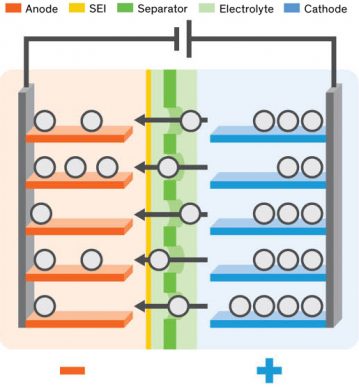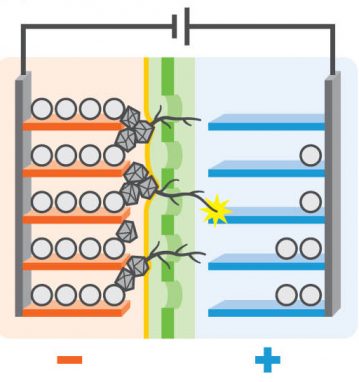
A South Korean news agency is citing anonymous industry sources in the the cause of the atypical battery fires in the Bolt and Kona LG EV batteries.
It was three months ago when the 2017-2019 Chevy Bolt EVs were recalled due to battery fires. It’s also been four months since the Kona EV was recalled for the same problem, and 2 months since they stopped selling it in Korea. There has been little word from either company (although one small update was provided by GM yesterday), but it appears an answer may be on the horizon.
Citing anonymous industry sources, Business Korea and NewDaily are claiming that Hyundai Motor’s Namyang Research Institute has found the problem of the battery fires. Hyundai is rumored to have concluded that the cell separator is the problem, and, if so, LG may go after their supplier for damages.
More importantly, the only remedy for this is apparently to replace all of the affected battery packs or keep the batteries from charging fully. GM currently caps its Bolts from charging beyond 90% to 95%.
Tesla had a similar fix with its Model S 85kWh battery packs and secretly cut around 10% of the range of the batteries in a software update. The automaker is currently being sued by owners of those packs. After our report, Tesla said that the goal of the update was to “protect the battery and improve battery longevity,” and it resulted in a range loss for only “a small percentage of owners.”
It’s very important to note that LG has denied that this is the problem, but they have not provided any additional information. Hyundai is rumored to be ready to make an announcement with their findings within days.
What exactly does this mean?

In a lithium ion battery of any type, there are layers: one of anodes (negative electrodes), and one of cathodes (positive electrodes), with a separator in between. For most commonly used cells today, a liquid electrolyte is injected that contains the lithium ions in the form of salts. The separator is constructed in such a way that the ions can pass through the separator. They move toward the cathode when discharging, and toward the anode when charging. These sandwiches are either layered (in a pouch or prismatic cell), or wound (in a cylindrical cell). Typically there are dozens of layers used in total.
The plague of such a design is that something called dendrites can form, most commonly from overcharging, but also from any impurities whatsoever in the electrolyte. The electrolyte is a lithium salt in an organic solvent, and similar to other salts, they can facilitate growth of crystal structures. When this happens, they tend to grow dendrites like roots. If these grow in just the right way, they can pierce the separator and create a short between the cathode and anode. If the dendrite is strong enough, it will remain intact and cause the cell to heat up rapidly due to the short. Eventually, this will cause a fire.

Images from IEEE, credit to James Provost.
This particular problem has been known for decades; various techniques and technologies exist to prevent them from becoming a problem. Most dendrites are harmless and often will disintegrate on their own. But on rare occasion, they can cause a short bad enough to cause battery fires.
How does this apply to the Bolt and Kona battery fires?
One of the mechanisms for preventing this is to have a separator that resists the growth of, and puncture by, dendrites. Keeping in mind that this is just a rumor, if this story is true, it would appear that the separator used was inferior to design specifications. This allows the dendrites to grow and fires to occur. Note that this is only under extremely rare circumstances, but enough to be of long-term concern.
If this is the case, it is unlikely that there are any software fixes that could work around this problem. As dendrites can occur in any lithium ion battery at any charge level (although much more likely at a full charge), the only recourse is to replace the batteries. Estimates have been pegged at about $540 million for the Kona, and the Bolt has about the same number of affected vehicles. While $1.1 billion is nothing to sneeze at, it’s not an impossible amount for the three or four companies in question to provide.
Electrek‘s take
If this is the situation, it’s entirely unsurprising. Dendrites have been a major problem for lithium ion batteries since their inception, with many high-profile battery fires and recalls happening as a result of it. More than 64 recalls have happened, with a quarter being laptops and a third being hoverboards. Nearly all of the recalls are due to the potential for the battery to overheat, melt, or burst, posing fire and burn hazards.
Similarly – again assuming this is the problem – it’s a major one. While the odds of a fire are very low, leaving them without replacement, even with a reduced charge level or other software fix, would not eliminate the risk entirely. While gas fires are still much more common, I doubt that this is something that any manufacturer will be willing to live with while trying to move toward an all-electric future.
GM, in particular, is about to launch their new Bolt EV and EUV in just a few days. They have gone all-in on electric vehicles. This is not something that they can live with while trying to convince customers to switch away from gas. Having battery fires hanging over them as they try to do this will be disastrous.
Customers are going to need to have complete faith in the electric vehicles if the switch is to be made. GM has about $140 billion USD in sales a year, and Hyundai has about $90 billion. Between them the cost of doing a complete battery recall at $1.1 billion wouldn’t even really be noticed. Even if they couldn’t get LG or the manufacturer of the separator to foot all or part of the bill, it would still be a worthwhile price to pay if it ensures their future goes smoothly.
Perhaps a cash or credit incentive for those owners willing to accept a 5% to 10% loss of range makes the most sense here? They could also go Tesla’s route and see their owners in court.
Subscribe to Electrek on YouTube for exclusive videos and subscribe to the podcast.
Author: Sean Graham
Source: Electrek



